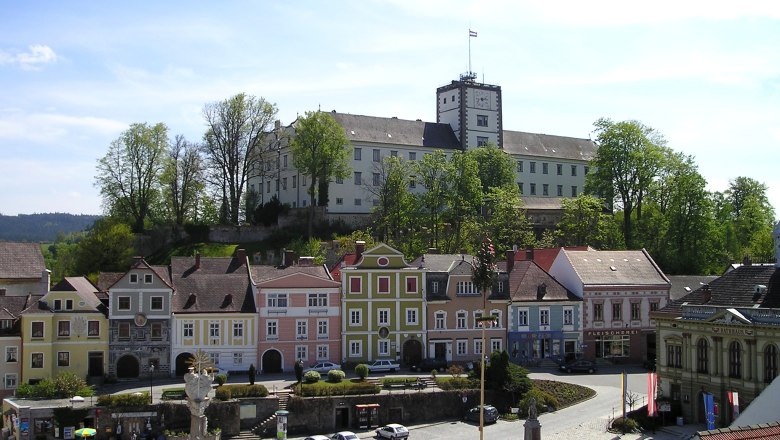Weitra Castle
From the tops of the towers to the depths of the cellars: History, (brewing) culture and new experiences.
Weitra Castle (German: Schloss Wietra) sits enthroned in the upper northwestern Waldviertel near the border with Bohemia. All eyes are drawn to the splendid Renaissance structure perched on the highest point above Austria’s oldest brewing town. People in this border area live in borderless diversity thanks to 800 years of history, the age-old art of brewing, and a varied calendar of events.
Civil service meets high nobility
Weitra Castle looks back on a thousand-year history. The fortified town was laid out from 1201 to 1208 by Hadmar II of Kuenring, son of the then leading family of ministeriales in the Waldviertel. In the then Districtus Witrensis, the town was the seat of military, administrative, judicial and ecclesiastical power and served as a market site and a place of refuge in wartime. Weitra subsequently grew to be one of the largest and richest towns in the entire Waldviertel at the time. In 1581 Hapsburg Emperor Rudolf II enfeoffed the town and associated domain to Baron Wolf Rumpf of Wielross – the castle was rebuilt after the plans of the imperial master builder Pietro Ferrabosco. Ferrabosco, who also built the Stallburg in Vienna, transformed the ancient walls into a magnificent Renaissance castle. After Rumpf’s death, the castle passed to the Counts of Fürstenberg and has been owned by that family ever since.
Baroque meets Renaissance
The castle has taken a heavy toll from fires and wars over the centuries, so the splendid landmark of Weitra did not begin to acquire its present-day appearance until the 18th c. The castle is an imposing rectangular structure with a tower rising above its northern longitudinal side. Four Baroque gables and the strictly structured three-story arcades bring life and movement to the large inner courtyard with its Renaissance fountain. In your mind’s eye you can still imagine the lady of the castle strolling through the castle today. The arcade pillars are decorated with lions’ heads, shells and stylized swords – all symbols of Santiago de Compostela: Wolf Rumpf of Wielross was grand master of the order of knights of the same name. You can almost hear the clanging of the swords here – fantastic!
History meets the art of brewing
The castle museum presents exhibits and artworks that whisk you off into the eventful history of the Kuenrings and the Fürstenbergs. At the same time, you gain insights into Waldviertel handicrafts, regional economic history and life in the homes of the nobles and the burghers. From the top of the tower, you enjoy impressive views of Weitra with its medieval town wall and far over the border into the countryside beyond. The Weitra Democracy Forum fittingly draws a historical connection to the former border area in its permanent exhibition about the Iron Curtain. Various sections of the Iron Curtain are heavily emphasized, with the individual stops and situations conveying specific impressions of life on both sides of the border.
Lighter, highly agreeable fare can be had in the Beer Museum in the cellar of the castle – along with a foray into the centuries-old brewing culture in Weitra. The castle, for its part, offers vibrant cultural fare: the famous Weitra Festival as well as concerts, readings, theater productions, exhibitions and workshops for adults and children. The curtain rises in the arcade courtyard – welcome to Weitra Castle!
